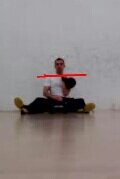Advantages of the kettlebell for traditional exercises
The kettlebell (kbell/s) and it's exercises garner a fair amount of apprehension because of the athleticism, or lack thereof, they can reveal. Many feel their lack of coordination confines them to traditional/less-athletic exercises never using the kbell. Truth is, however, that kbells offer certain advantages over dumbbells/barbells for many traditional exercises.
Among the advantages of kbells for traditional dumbbell/barbell exercises are variance in load-angle and range of motion. Exercises that display the aforementioned advantages of kbells include overhead presses, and rows. The advantages the kbell offers for these exercises are explained/illustrated below.
Overhead presses
For overhead presses kbells offer both unique loading and and increased range of motion.
Unique loading
 |
 |
As displayed by the red-arrow in the right photo above, the kbell, due to its weight distribution, places external rotation force on the shoulder joint. Potential advantage to this external rotation force on the shoulder is a reduced demand on the external rotators of the shoulder (teres minor, infraspinatus, and supraspinatus); which are often vulnerable with presses. If dealing with vulnerable external rotators, the assistance of the kbell in maintaining an externally rotated position might allow for more productive pressing.
In the left photo above, the bell is being pressed with the bottom up. With the bottom up, the entire rotator cuff (teres minor, infraspinatus, supraspinatus, subscapularis) and grip is called upon to ensure force remains in-line with the load. This harmonious cooperation among these muscles often elicits a feeling of the shoulder being "reset". Furthermore, the intense bar-gripping often advocated for presses is unconsciously mandated pressing the bell bottom up.
Increased range of motion
 |
 |
In the above photos. it's evident that the kbell allows pressing from a deeper position. The advantage of being able to press from a deeper position is increased strength at deeper joint angles. This increased strength helps ensure greater joint integrity at said joint angle.
Rows
Rows can be complimented by kbells because of different loading and range also. In the case of the row, however, load is actually better balanced with the kbell versus the dumbbell. As for range, the kbell allows for greater retraction. These load and range differences are covered below.
More balanced loading
 |
 |
Illustrated by the red lines in the above [photos, the dumbbell imposes less linear resistance than the kettlebell. The more balanced loading offered by the kbell likely allows for more forceful rowing, especially for those narrow palms.
Greater range of motion
 |
 |
Depicted by the red reference line in the photos above, is they greater retraction allowed by the kbell. With the prevalence if poor posture, adequate retraction is important.
What to walk away with
While the kettlebell, and its signature exercises conjure fear among many, its uses extend to exercises most people are comfortable with. being shaped differently than dumbbells, kettlebells allow for unique loading and range of motion for many traditional exercises. As such, integration of kbells into routines, can be both comfortable and productive!